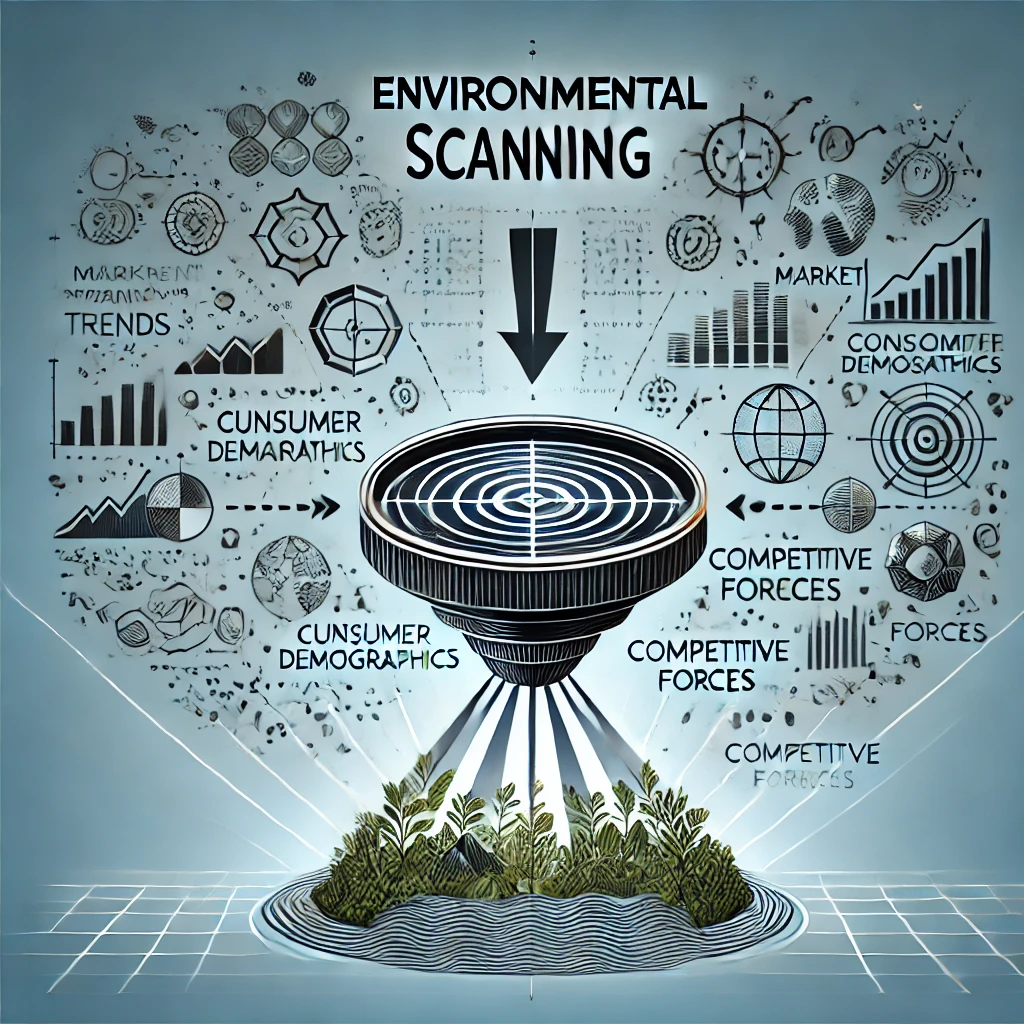Staying current and competitive in an increasingly dynamic business environment nowadays, firms rely on processes for environmental scanning. From such a concept, systematic observation, analysis, and interpretation of the internal and external environment will determine the tendencies, opportunities, or even threats to an organization that must arise. This approach provides proactive action to set its business strategies in step with the changing conditions to align and thus become long-term adaptive and successful.
What is Environmental Scanning?
Environmental scanning is a necessary process for any organization in order to steer itself through a constantly changing market. The process requires data gathering from multiple sources of economic, social, technological, and political environments and determining how they may affect the business’s operations. It helps organizations anticipate change and prepare themselves rather than simply reacting to changes.
Environmental scanning is very useful in identifying not only external threats but also internal capabilities, which can be used effectively by the organization. This information is used to inform strategic decisions, risk management, and adaptation to changing market dynamics, which helps the business maintain a competitive edge.
Characteristics of Environmental Scanning
A well-conducted environmental scan has distinct characteristics, each crucial to gaining a comprehensive understanding of external and internal conditions:
- Continuous Process: Environmental scanning is a continuous process to ensure that the organizations are updated on emerging trends and sudden changes.
- Systematic Approach: The scanning process is planned and organized, so the important information is not missed; data is obtained from various sources.
- Objective Analysis: Analysis with objectivity helps an organization avoid biased thinking and misinterpretation of external factors.
- Full Scan: Technological, social, economic, and competitive factors that will affect the business are integrated into comprehensive scanning.
- Strategic Orientation: The main role of scanning is to guide strategic planning in such a direction that the organization can manage its activities in the altering environment.
These characteristics help businesses stay relevant, competitive, and aware of any threats and opportunities in the environment, contributing to a proactive rather than reactive approach.

Components of Environmental Scanning
Understanding the components of environmental scanning is vital, as it allows businesses to focus on specific areas that could directly affect their success. The four key components are:
External Environment
- Political Factors: Regulations, government policies, and political stability significantly affect business operations.
- Economic Factors: Inflation rates, economic growth, and exchange rates can impact business profitability.
- Social Factors: Demographic shifts, lifestyle changes, and cultural trends influence consumer behavior and preferences.
- Technological Factors: Innovations, advancements, and automation change the way businesses operate and compete.
Internal Environment
- Organizational Structure: An efficient structure facilitates quick adaptation to changes, enhancing competitiveness.
- Employee Skills: The talent and expertise within the organization are critical for executing strategies in response to environmental changes.
- Corporate Culture: A strong culture supports resilience and fosters a proactive approach to change.
Industry Environment
- Competitive Landscape: Knowing the strategies, strengths, and weaknesses of competitors is how companies position themselves effectively.
- Supply Chain Dynamics: Reliable suppliers and resilient distribution channels are needed for business continuity.
- Market Trends: Changing consumer preferences, technological advancements, and emerging markets define the industry environment.
Macro Environment
- Global Economic Conditions: Economic stability and growth rates influence consumer spending and investment.
- Technological Advancements: Emerging technologies can disrupt markets, necessitating adaptation or innovation.
- Environmental Factors: Sustainability practices and regulatory requirements impact industries such as manufacturing, agriculture, and retail.
Techniques of Environmental Scanning
Environmental scanning employs a variety of techniques to gather, analyze, and interpret data from the environment. The most widely used techniques include:
- SWOT Analysis: Strengths, Weaknesses, Opportunities, and Threats – balancing the organization’s internal factors with external factors.
- PEST Analysis: Political, Economic, Social, and Technological factors, which impact an organization, thereby explaining how to determine the influence of external factors.
- Porter’s Five Forces Model: Analyzing the competitive forces by threat of new entrants, power of suppliers, power of buyers, and threat of substitutes.
- Trend Analysis: It provides the trends of the long-run change in the market and guides the businesses to make changes in their strategies for adapting to the changes near the future.
- Scenario Planning: This involves creating more than one scenario of the future so that the organization prepares itself for the likely outcomes and makes plans for the same.
- Benchmarking: It is the comparison of the performance of an organization with the competitors or with the industry standards to identify the areas of improvement.
These techniques help businesses identify key factors impacting their operations, enabling them to develop targeted strategies to address potential challenges and capitalize on opportunities.
Important Factors for Environmental Scanning
Successful environmental scanning considers several critical factors to ensure accuracy and relevance:
- Scope of Scanning: Defining the scope helps narrow down relevant environmental factors, making the scanning process more efficient and focused.
- Frequency of Scanning: Regular scanning allows organizations to stay updated with the latest trends and threats in real time.
- Data Sources: A diverse range of reliable data sources, including reports, news articles, and market research, is essential for comprehensive scanning.
- Human Resources: Skilled analysts who can interpret complex data play a pivotal role in translating environmental scans into actionable insights.
- Technology Utilization: Using AI, data analytics, and predictive tools enhances the speed and accuracy of the scanning process.
Each of these factors is crucial for ensuring that environmental scanning remains a valuable tool for decision-making and strategy formulation.
Process of Environmental Analysis
The process of environmental analysis is methodical, designed to systematically analyze factors that could impact business success. This process can be broken down into several key steps:
- Identify Scanning Needs and Objectives: Establishing the purpose of scanning, such as assessing new market opportunities or monitoring competitors, guides the scope and focus.
- Collect Relevant Information: Gather data from both internal and external sources, including industry reports, competitor insights, and technological trends.
- Analyze Information: This step involves interpreting the collected data to identify patterns, correlations, and potential implications for the organization.
- Forecast and Anticipate Changes: Use forecasting tools and predictive models to identify potential future developments in the environment.
- Develop Action Plans: Based on the analysis, create strategic plans to respond to opportunities and mitigate risks.
- Monitor and Review: Environmental scanning is a continuous process, requiring regular monitoring and adjustments based on the latest information.
In a world where markets, technologies, and consumer preferences are constantly evolving, environmental scanning is indispensable for businesses striving to stay competitive and resilient. By understanding the external and internal factors that shape their environment, organizations can proactively align their strategies with emerging trends and potential disruptions. Through structured scanning processes and the application of analytical techniques, businesses gain insights that foster adaptability, ensuring their relevance and sustainability in dynamic markets.
Environmental Scanning FAQs
What is environmental scanning in strategic management?
Environmental scanning in strategic management involves analyzing external and internal factors to inform decision-making and strategic planning, helping companies anticipate and adapt to market changes.
Why is environmental scanning important?
Environmental scanning is essential because it enables companies to identify emerging threats and opportunities, equipping them with the insights necessary for effective strategy development.
How does SWOT analysis aid environmental scanning?
SWOT analysis aids environmental scanning by highlighting an organization’s strengths, weaknesses, opportunities, and threats, giving a holistic view of internal and external factors.
What are the primary techniques of environmental scanning?
Common techniques include PEST analysis, SWOT analysis, Porter’s Five Forces, scenario planning, and trend analysis.
What factors influence effective environmental scanning?
Effective environmental scanning is influenced by factors such as scanning scope, data sources, scanning frequency, analyst expertise, and the use of technology.


